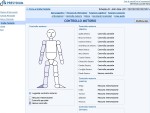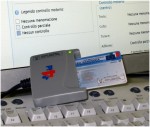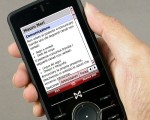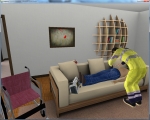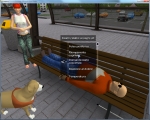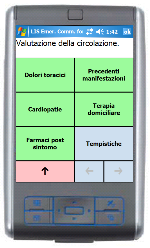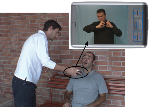

PROJECT RESULTS (as of December 2012)
The main results achieved so far by the project are:
- PRESYDIUM, a web-based system to support emergency medical services for disabled patients.
- EMSAVE, a virtual training environment for emergency medical procedures concerning disabled patients.
- SLEC, a mobile system to support communication between first responders and deaf patients.
- Help!, a serious game for learning the guidelines on emergency evacuation of disabled persons.
- Scientific publications.
THE PRESYDIUM SYSTEM
Our PRESYDIUM (PeRsonalized Emergency SYstem for DIsabled hUMans) system has been designed to (i) allow physicians, disabled persons and their relatives to access and manage personal medical profiles, and (ii) provide Emergency Medical Service (EMS) personnel with tailored operating instructions based on the disabled persons' profiles.
To reach such goals, domain knowledge was preliminarly acquired and formalized as follows:
- We defined a Disabled Person Profile (DPP), i.e., a detailed patient model (based on the ICF standard) for EMS that can account for peculiar aspects of the many existing disabilities.
- We developed a medical knowledge base to generate personalized operating instructions for medical first responders based on the specific needs of each disabled person.
Such preliminary activities were carried out by conducting focus groups involving: (i) EMS physicians and nurses, (ii) rehabilitation clinicians specialized in disabilities, and (iii) representatives of various Italian associations of disabled persons.
The PRESYDIUM system is a 3-tier Web application, based on the above mentioned DPP and the medical knowledge base, providing:
- A Web portal: the PRESYDIUM Web Portal allows disabled users, their relatives and physicians to access DPPs through a user interface that adapts to user category and user disabilities. All kinds of users who are involved in managing DPPs access the system through any Web browser. The user interface of the Web Portal has been developed in conformance with W3C Web Content Accessibility Guidelines 2.0. PRESYDIUM can be also accessed using the European Health Insurance Card for authentication.
- A Web service for DPP retrieval: PRESYDIUM provides fast search and retrieval functionalities of DPP data to phone operators of the EMS center through either automatic caller identification or quick search functionality from the typical information that is requested anyway during an emergency call. Since each ambulance run has an associated team of first responders, the phone operator can assign the DPP to that ambulance run, enabling the members of that team to read system recommendations from their mobile devices. A Desktop Client application to access the service from PCs has been developed.
- A Web service for the generation of personalized operating instructions: first responders read the personalized operating instructions provided by PRESYDIUM while they are traveling to the emergency destination. A Mobile Client application to access the service has been developed for Windows-based mobile devices.
Field testing of the PRESYDIUM system: an extensive user evaluation has been carried out on the different parts of the developed software, with the collaboration of all categories of users involved in different application areas: medical (general practitioners and clinicians), persons with disabilities (and their families), EMS nurses. The results of these trials have provided positive feedback, from the different categories of users. Currently we have just started two evaluations which are crucial for the deployment of the system: (i) testing the use of the mobile system PRESYDIUM by the medical staff in the ambulance, (ii) testing the PRESYDIUM system within an emergency room (it should be noted that disabled patients have particular assistance needs that go beyond the stage of first aid and transport to the hospital).
Demo video of the PRESYDIUM system
THE EMSAVE SYSTEM
EMSAVE ("Emergency Medical Services for the disAbled" Virtual Environment) is a virtual reality system for training in emergency medical procedures concerning disabled persons.
The creation process started by writing emergency scenarios together with EMS experts. We adopted a task modeling formalism to represent tasks that users have to perform to carry out the emergency medical procedure (e.g., put oxygen mask on, transfer to stretcher, etc.) and the temporal relations among them (e.g., consequentiality, contemporarity, etc.). Task models are represented in a XML format, which is used by the system to control the simulation as well as to check users' actions and suggest the correct ones.
During the simulations, users can freely explore the virtual environment. The system allows users to choose what actions to perform among a set of possibilities that depends on the difficulty level. The selection of an action by the user triggers specific events in the simulation, for example the execution of some animation (e.g., the nurse character performing an action) or some visible effect on the patient (e.g., turning pale). The main features of the preliminary prototype of the system we developed are shown in the first video below.
We carried out an evaluation of this preliminary prototype with EMS nurses. The main purposes of the study were to assess nurses' acceptance of this kind of application, as well as to collect suggestions and requirements. Nurses showed a high acceptance of the system, which proved very easy to use and was recognized as a useful tool for retraining.
Based on feedback from nurses and Advanced Life Support (ALS) instructor, we then developed the final version of EMSAVE, which features several improvements in terms of user interaction, graphical realism and flexibility of training support. In particular, this new version can simulate a wide range of medical emergency scenarios and includes an improved pedagogical mechanism: if users select a wrong action, EMSAVE summarizes the current situation and provides hints for self-correction. The final version of EMSAVE is illustrated in the second video below.
The final version of EMSAVE was evaluated with 40 nurses and doctors in the context of an official retraining course organized by Udine Hospital. The evaluation showed that EMSAVE is an effective tool for retraining ALS skills and that knowledge acquired by using the system is retained at three months.
We are currently extending the system with adaptive modules that can automatically generate scenarios starting from the guidelines for the different disabilities. Moreover, the adaptive modules will also be able to suggest to each trainee which procedures and disabilities (s)he should focus on by considering individual results achieved in previous training sessions.
Demo video of the preliminary prototype of EMSAVE (2009-2010)
Demo video of the final version of EMSAVE (2012)
THE SLEC SYSTEM
SLEC (Sign Language Emergency Communicator) is a mobile system to support communication between deaf patients who communicate in sign language and emergency medical responders.
Fast and effective communication is crucial during medical emergencies. For example, emergency medical responders should quickly and accurately elicit information about patients' symptoms to provide them with the most appropriate treatments. However, emergency medical responders usually do not understand sign languages, and improvised speech and gesture-based communication can require much time and effort and lead to misunderstandings. Therefore, SLEC allows emergency medical responders to quickly browse a collection of emergency-related sentences, and show videos of the corresponding translations in sign language to the deaf patients.
The design of SLEC involved experts in emergency medicine to identify and hierarchically organize the relevant sentences, as well as address constraints due to the activities to perform, their timing, the available equipment, and the environment where emergencies take place. We also involved experts from the deaf community to identify deaf people needs during a medical emergency and preferred means to communicate, as well as to translate and film sentences in sign language.
The SLEC prototype can be installed on mobile phones and has been evaluated on real scenarios involving emergency medical responders and deaf people. The evaluation showed that the system is useful to support communication with deaf people during medical emergencies.
Demo video of the SLEC system
THE HELP! SYSTEM
"Help!" Is a serious game (publicly available on the Web at http://www.facebook.com/HelpTheSeriousGame) that allows anyone to acquire knowledge about how to help disabled persons in emergency situations.
In the currently available game levels, players are faced with events such as an earthquake or a fire, with the goal of helping a disabled person in the evacuation of a building. The initial level is instead a training gym that allows one to learn the concepts necessary to help the disabled, under the guidance of a virtual fireman. The guidelines taught by the game are those officially recommended by the National Fire Corps (see http://www.vigilfuoco.it/allegati/biblioteca/legge_disabili.pdf).
Demo video of the Help! serious game
SCIENTIFIC PUBLICATIONS
- Cabas Vidani A., Chittaro L., Using a Task Modeling Formalism in the Design of Serious Games for Emergency Medical Procedures, Proceedings of VS-GAMES'09: IEEE First International Conference on Games and Virtual Worlds for Serious Applications, IEEE Computer Society Press, Los Alamitos, CA, USA, 2009, pp. 95-102.
[See abstract and download PDF] - Chittaro L., Ranon R., De Marco L., Senerchia A., User modeling of disabled persons for generating instructions to medical first responders, Proceedings of the International Conference on User Modeling, Adaptation, and Personalization (UMAP 2009), Springer-Verlag, Berlin, 2009.
[See abstract and download PDF] - Chittaro L., Ranon R., Carchietti E., Zampa A., Biasutti E., De Marco L., Senerchia A., A knowledge-based system to support emergency medical services for disabled patients, Proceedings of the 12th Conference on Artificial Intelligence in Medicine (AIME'09), Springer-Verlag, Berlin, 2009, pp. 176-180.
[See abstract and download PDF] - Cabas Vidani A., Chittaro L., Carchietti E., Assessing nurses' acceptance of a serious game for emergency medical services, Proceedings of VS-GAMES 2010: 2nd International Conference on Games and Virtual Worlds for Serious Applications, IEEE Computer Society Press, Los Alamitos, CA, USA, March 2010, pp. 101-108.
[See abstract and download PDF] - Buttussi F., Chittaro L., Carchietti E., Coppo M., Using mobile devices to support communication between emergency medical responders and deaf people, Proceedings of MobileHCI 2010: 12th International Conference on Human-Computer Interaction with Mobile Devices and Services, ACM Press, New York, September 2010, pp. 7-16.
[See abstract and download PDF] - Chittaro L., Carchietti E., De Marco L., Zampa A., Personalized emergency medical assistance for disabled people, User Modeling and User-Adapted Interaction (UMUAI) Journal, Vol. 20, no. 4-5, 2011, pp. 407-440.
[See abstract and download PDF] - Buttussi F., Pellis T., Cabas Vidani A., Pausler D., Carchietti E., Chittaro L., Evaluation of a 3D serious game for advanced life support retraining, International Journal of Medical Informatics, Vol. 82, No. 9, 2013, pp. 798–809.
[See abstract and download PDF]
 ]
]